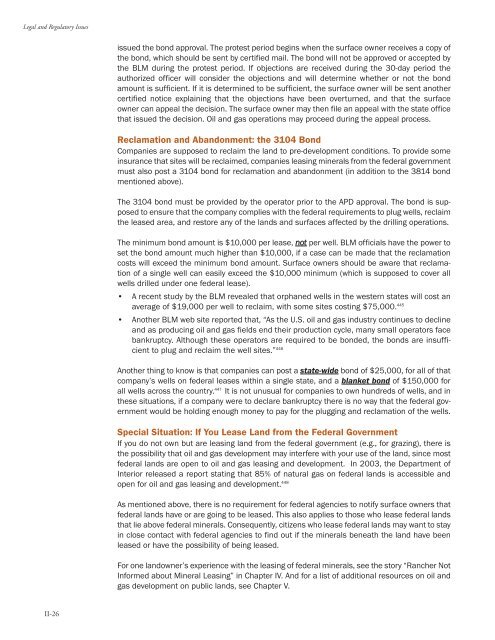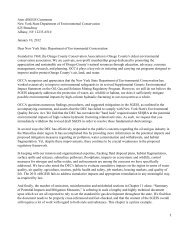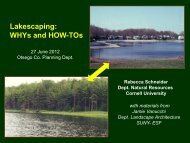Oil and Gas at Your Door? (2005 Edition) - Earthworks
Oil and Gas at Your Door? (2005 Edition) - Earthworks
Oil and Gas at Your Door? (2005 Edition) - Earthworks
You also want an ePaper? Increase the reach of your titles
YUMPU automatically turns print PDFs into web optimized ePapers that Google loves.
Legal <strong>and</strong> Regul<strong>at</strong>ory Issues<br />
issued the bond approval. The protest period begins when the surface owner receives a copy of<br />
the bond, which should be sent by certified mail. The bond will not be approved or accepted by<br />
the BLM during the protest period. If objections are received during the 30-day period the<br />
authorized officer will consider the objections <strong>and</strong> will determine whether or not the bond<br />
amount is sufficient. If it is determined to be sufficient, the surface owner will be sent another<br />
certified notice explaining th<strong>at</strong> the objections have been overturned, <strong>and</strong> th<strong>at</strong> the surface<br />
owner can appeal the decision. The surface owner may then file an appeal with the st<strong>at</strong>e office<br />
th<strong>at</strong> issued the decision. <strong>Oil</strong> <strong>and</strong> gas oper<strong>at</strong>ions may proceed during the appeal process.<br />
Reclam<strong>at</strong>ion <strong>and</strong> Ab<strong>and</strong>onment: the 3104 Bond<br />
Companies are supposed to reclaim the l<strong>and</strong> to pre-development conditions. To provide some<br />
insurance th<strong>at</strong> sites will be reclaimed, companies leasing minerals from the federal government<br />
must also post a 3104 bond for reclam<strong>at</strong>ion <strong>and</strong> ab<strong>and</strong>onment (in addition to the 3814 bond<br />
mentioned above).<br />
The 3104 bond must be provided by the oper<strong>at</strong>or prior to the APD approval. The bond is supposed<br />
to ensure th<strong>at</strong> the company complies with the federal requirements to plug wells, reclaim<br />
the leased area, <strong>and</strong> restore any of the l<strong>and</strong>s <strong>and</strong> surfaces affected by the drilling oper<strong>at</strong>ions.<br />
The minimum bond amount is $10,000 per lease, not per well. BLM officials have the power to<br />
set the bond amount much higher than $10,000, if a case can be made th<strong>at</strong> the reclam<strong>at</strong>ion<br />
costs will exceed the minimum bond amount. Surface owners should be aware th<strong>at</strong> reclam<strong>at</strong>ion<br />
of a single well can easily exceed the $10,000 minimum (which is supposed to cover all<br />
wells drilled under one federal lease).<br />
• A recent study by the BLM revealed th<strong>at</strong> orphaned wells in the western st<strong>at</strong>es will cost an<br />
average of $19,000 per well to reclaim, with some sites costing $75,000. 445<br />
• Another BLM web site reported th<strong>at</strong>, “As the U.S. oil <strong>and</strong> gas industry continues to decline<br />
<strong>and</strong> as producing oil <strong>and</strong> gas fields end their production cycle, many small oper<strong>at</strong>ors face<br />
bankruptcy. Although these oper<strong>at</strong>ors are required to be bonded, the bonds are insufficient<br />
to plug <strong>and</strong> reclaim the well sites.” 446<br />
Another thing to know is th<strong>at</strong> companies can post a st<strong>at</strong>e-wide bond of $25,000, for all of th<strong>at</strong><br />
company’s wells on federal leases within a single st<strong>at</strong>e, <strong>and</strong> a blanket bond of $150,000 for<br />
all wells across the country. 447 It is not unusual for companies to own hundreds of wells, <strong>and</strong> in<br />
these situ<strong>at</strong>ions, if a company were to declare bankruptcy there is no way th<strong>at</strong> the federal government<br />
would be holding enough money to pay for the plugging <strong>and</strong> reclam<strong>at</strong>ion of the wells.<br />
Special Situ<strong>at</strong>ion: If You Lease L<strong>and</strong> from the Federal Government<br />
If you do not own but are leasing l<strong>and</strong> from the federal government (e.g., for grazing), there is<br />
the possibility th<strong>at</strong> oil <strong>and</strong> gas development may interfere with your use of the l<strong>and</strong>, since most<br />
federal l<strong>and</strong>s are open to oil <strong>and</strong> gas leasing <strong>and</strong> development. In 2003, the Department of<br />
Interior released a report st<strong>at</strong>ing th<strong>at</strong> 85% of n<strong>at</strong>ural gas on federal l<strong>and</strong>s is accessible <strong>and</strong><br />
open for oil <strong>and</strong> gas leasing <strong>and</strong> development. 448<br />
As mentioned above, there is no requirement for federal agencies to notify surface owners th<strong>at</strong><br />
federal l<strong>and</strong>s have or are going to be leased. This also applies to those who lease federal l<strong>and</strong>s<br />
th<strong>at</strong> lie above federal minerals. Consequently, citizens who lease federal l<strong>and</strong>s may want to stay<br />
in close contact with federal agencies to find out if the minerals bene<strong>at</strong>h the l<strong>and</strong> have been<br />
leased or have the possibility of being leased.<br />
For one l<strong>and</strong>owner’s experience with the leasing of federal minerals, see the story “Rancher Not<br />
Informed about Mineral Leasing” in Chapter IV. And for a list of additional resources on oil <strong>and</strong><br />
gas development on public l<strong>and</strong>s, see Chapter V.<br />
II-26




